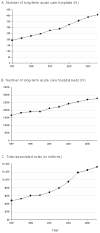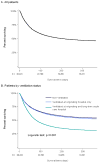Long-term acute care hospital utilization after critical illness
- PMID: 20530778
- PMCID: PMC3094575
- DOI: 10.1001/jama.2010.761
Long-term acute care hospital utilization after critical illness
Abstract
Context: Long-term acute care hospitals have emerged as a novel approach for the care of patients recovering from severe acute illness, but the extent and increases in their activity at the national level are unknown.
Objective: To examine temporal trends in long-term acute care hospital utilization after an episode of critical illness among fee-for-service Medicare beneficiaries aged 65 years or older.
Design, setting, and patients: Retrospective cohort study using the Medicare Provider Analysis and Review files from 1997 to 2006. We included all Medicare hospitalizations involving admission to an intensive care unit of an acute care, nonfederal hospital within the continental United States.
Main outcome measures: Overall long-term acute care utilization, associated costs, and survival following transfer.
Results: The number of long-term acute care hospitals in the United States increased at a mean rate of 8.8% per year, from 192 in 1997 to 408 in 2006. During that time, the annual number of long-term acute care admissions after critical illness increased from 13,732 to 40,353, with annual costs increasing from $484 million to $1.325 billion. The age-standardized population incidence of long-term acute care utilization after critical illness increased from 38.1 per 100,000 in 1997 to 99.7 per 100,000 in 2006, with greater use among male individuals and black individuals in all periods. Over time, transferred patients had higher numbers of comorbidities (5.0 in 1997-2000 vs 5.8 in 2004-2006, P < .001) and were more likely to receive mechanical ventilation at the long-term acute care hospital (16.4% in 1997-2000 vs 29.8% in 2004-2006, P < .001). One-year mortality after long-term acute care hospital admission was high throughout the study period: 50.7% in 1997-2000 and 52.2% in 2004-2006.
Conclusions: Long-term acute care hospital utilization after critical illness is common and increasing. Survival among Medicare beneficiaries transferred to long-term acute care after critical illness is poor.
Conflict of interest statement
Figures



Comment in
-
Critically ill patients and long-term acute care hospitals.JAMA. 2010 Oct 6;304(13):1441-2; author reply 1442-3. doi: 10.1001/jama.2010.1399. JAMA. 2010. PMID: 20924006 No abstract available.
-
Critically ill patients and long-term acute care hospitals.JAMA. 2010 Oct 6;304(13):1442; author reply 1442-3. doi: 10.1001/jama.2010.1400. JAMA. 2010. PMID: 20924007 No abstract available.
-
Recommended reading from northwestern university fellows: peter h. S. Sporn, program director.Am J Respir Crit Care Med. 2011 Oct 1;184(7):857-8. doi: 10.1164/rccm.201102-0293RR. Am J Respir Crit Care Med. 2011. PMID: 21965017 No abstract available.
References
-
- Carson SS, Bach PB. The epidemiology and costs of chronic critical illness. Crit Care Clin. 2002;18:461–476. - PubMed
-
- Kahn JM. The evolving role of dedicated weaning facilities in critical care. Intensive Care Med. 2009 - PubMed
-
- Carson SS. Know your long-term care hospital. Chest. 2007;131:2–5. - PubMed
-
- Scheinhorn DJ, Hassenpflug MS, Votto JJ, et al. Ventilator-dependent survivors of catastrophic illness transferred to 23 long-term care hospitals for weaning from prolonged mechanical ventilation. Chest. 2007;131:76–84. - PubMed
-
- MacIntyre NR, Epstein SK, Carson S, Scheinhorn D, Christopher K, Muldoon S. Management of patients requiring prolonged mechanical ventilation: report of a NAMDRC consensus conference. Chest. 2005;128:3937–3954. - PubMed

